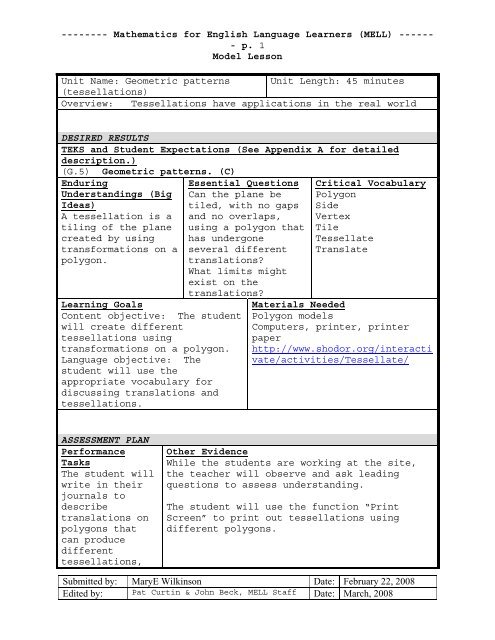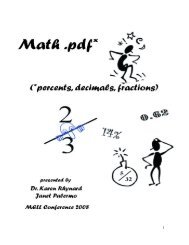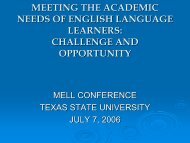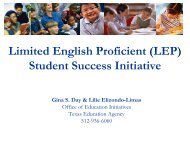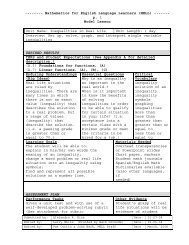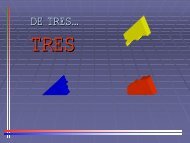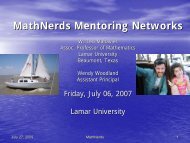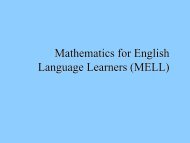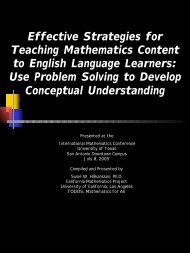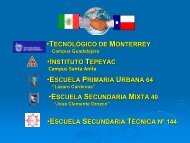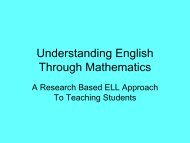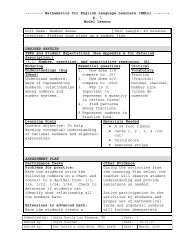Geometric patterns - Mathematics for English Language Learners ...
Geometric patterns - Mathematics for English Language Learners ...
Geometric patterns - Mathematics for English Language Learners ...
Create successful ePaper yourself
Turn your PDF publications into a flip-book with our unique Google optimized e-Paper software.
-------- <strong>Mathematics</strong> <strong>for</strong> <strong>English</strong> <strong>Language</strong> <strong>Learners</strong> (MELL) ------<br />
- p. 1<br />
Model Lesson<br />
Unit Name: <strong>Geometric</strong> <strong>patterns</strong> Unit Length: 45 minutes<br />
(tessellations)<br />
Overview: Tessellations have applications in the real world<br />
DESIRED RESULTS<br />
TEKS and Student Expectations (See Appendix A <strong>for</strong> detailed<br />
description.)<br />
(G.5) <strong>Geometric</strong> <strong>patterns</strong>. (C)<br />
Enduring<br />
Understandings (Big<br />
Ideas)<br />
A tessellation is a<br />
tiling of the plane<br />
created by using<br />
trans<strong>for</strong>mations on a<br />
polygon.<br />
Learning Goals<br />
Content objective: The student<br />
will create different<br />
tessellations using<br />
trans<strong>for</strong>mations on a polygon.<br />
<strong>Language</strong> objective: The<br />
student will use the<br />
appropriate vocabulary <strong>for</strong><br />
discussing translations and<br />
tessellations.<br />
Essential Questions<br />
Can the plane be<br />
tiled, with no gaps<br />
and no overlaps,<br />
using a polygon that<br />
has undergone<br />
several different<br />
translations?<br />
What limits might<br />
exist on the<br />
translations?<br />
Critical Vocabulary<br />
Polygon<br />
Side<br />
Vertex<br />
Tile<br />
Tessellate<br />
Translate<br />
Materials Needed<br />
Polygon models<br />
Computers, printer, printer<br />
paper<br />
http://www.shodor.org/interacti<br />
vate/activities/Tessellate/<br />
ASSESSMENT PLAN<br />
Per<strong>for</strong>mance<br />
Tasks<br />
The student will<br />
write in their<br />
journals to<br />
describe<br />
translations on<br />
polygons that<br />
can produce<br />
different<br />
tessellations,<br />
Other Evidence<br />
While the students are working at the site,<br />
the teacher will observe and ask leading<br />
questions to assess understanding.<br />
The student will use the function “Print<br />
Screen” to print out tessellations using<br />
different polygons.<br />
Submitted by: MaryE Wilkinson Date: February 22, 2008<br />
Edited by: Pat Curtin & John Beck, MELL Staff Date: March, 2008
including<br />
connections to<br />
the real world.<br />
2<br />
GENERAL MELL CONNECTIONS THAT APPLY TO ALL LESSONS<br />
(MC-01) - To assist the ELLs, the teacher should avoid speaking<br />
too rapidly and when possible use basic words rather than<br />
unfamiliar ones to introduce new concepts.<br />
(MC-02) - Teachers should foster trusting relationships with<br />
ELLs through in<strong>for</strong>mal conversations and presentation of a<br />
culturally rich classroom.<br />
(MC-03) - ELLs may need extra opportunities to demonstrate<br />
mastery. Grading policies should be flexible enough to provide<br />
multiple learning opportunities without severe grade penalties.<br />
(MC-04) - ELLs may work at a slower pace than other students<br />
because of limited <strong>English</strong> language skills and should be<br />
provided with shortened assignments, or when appropriate, extra<br />
time to work on assignments.<br />
(MC-05) - ELLs should be scheduled in a math class that has<br />
students who have some proficiency in both languages. Teachers<br />
may need to work with counselors and others to ensure that this<br />
happens.<br />
(MC-06) - Teachers should offer tutoring as frequently as<br />
possible and encourage ELLs to come in <strong>for</strong> extra assistance. If<br />
possible, the teacher should arrange <strong>for</strong> an aide or parent<br />
volunteer who speaks the language of the ELL to help with<br />
LEARNING PLAN<br />
http://www.shodor.org/interactivat<br />
e/activities/Tessellate/<br />
The site has sections <strong>for</strong> the<br />
teacher and the learner, as well<br />
as a help screen and the activity.<br />
The teacher will review the site<br />
be<strong>for</strong>e the lesson.<br />
The teacher will provide sketches<br />
to assist students with the<br />
vocabulary. The three regular<br />
polygons that the students will<br />
use in the investigation are<br />
triangle, rectangle, and hexagon.<br />
See Figures 1 and 2. (MC-09), (MC-<br />
MELL Connections<br />
(MC-09) - To assist<br />
the ELLs, the teacher<br />
should model the expected<br />
task and use visual<br />
representations<br />
to<br />
rein<strong>for</strong>ce concepts and/or<br />
steps in the problemsolving<br />
process. Critical<br />
concepts should be clearly<br />
emphasized and repeated.<br />
(MC-12) - ELLs should be<br />
given numerous<br />
opportunities to write
12), (MC-16)<br />
During the discussion, the teacher<br />
will emphasize what a tiling is.<br />
See Figure 3.<br />
As soon as possible, the teacher<br />
will allow the students to<br />
explore, on their own,<br />
tessellations on triangles,<br />
rectangles, and hexagons. As the<br />
students work, the teacher will<br />
observe and ask leading questions,<br />
such as, “Will all polygons tile<br />
the plane?” “Where in the real<br />
world have you seen something like<br />
your tessellation?” and “Is there<br />
a limit to the number and/or size<br />
of the translations that will<br />
create a figure that will tile the<br />
plane?” See Figure 4. After the<br />
students have printed<br />
tessellations they created on<br />
triangles, rectangles, and<br />
hexagons, they will write about<br />
the experience and answer the two<br />
questions. (MC-12), (MC-16)<br />
about the mathematics<br />
concepts they are<br />
learning. Journal<br />
entries, <strong>for</strong> example,<br />
provide opportunities <strong>for</strong><br />
the students to<br />
crystallize their thinking<br />
about concepts and <strong>for</strong> the<br />
teacher to check <strong>for</strong><br />
understanding. Students<br />
who have limited <strong>English</strong><br />
language skills should be<br />
allowed to write in their<br />
first language initially<br />
and should not be<br />
penalized <strong>for</strong> spelling or<br />
grammar errors.<br />
.<br />
(MC-16) - When monitoring<br />
ELLs during instruction,<br />
the teacher should make a<br />
special ef<strong>for</strong>t to assist,<br />
re-explain and demonstrate<br />
again, if necessary.<br />
Encouragement and<br />
rein<strong>for</strong>cement should be<br />
used frequently..<br />
3
4<br />
Each angle is a vertex<br />
Each segment is a side<br />
The pentagon has 5 sides<br />
and 5 vertices<br />
Figure 1<br />
Triangle<br />
Rectangle<br />
Hexagon<br />
These are the only polygons available at the site.<br />
Figure 2<br />
A tiling can be as simple as a square grid on a floor<br />
Figure 3
5<br />
Trans<strong>for</strong>mations that do not “overlap” are OK.<br />
Trans<strong>for</strong>mations that “overlap” sides or other trans<strong>for</strong>mations<br />
will not work. The program will create a tessellation style<br />
graphic, but it isn’t a true tessellation.<br />
Figure 4
6<br />
<strong>English</strong> <strong>Language</strong> Proficiency Standards Quick Reference. (Chapter<br />
74. Curriculum Requirements Subchapter A. Required Curriculum,<br />
§74.4. <strong>English</strong> <strong>Language</strong> Proficiency Standards). The standards<br />
checked here are merely examples <strong>for</strong> the teacher's consideration<br />
<strong>for</strong> inclusion in this lesson.<br />
Cross-curricular second<br />
language acquisition/listening.<br />
The ELL listens to a variety of<br />
speakers including teachers,<br />
peers, and electronic media to<br />
gain an increasing level of<br />
comprehension of newly acquired<br />
language in all content areas.<br />
ELLs may be at the beginning,<br />
intermediate, advanced, or<br />
advanced high stage of <strong>English</strong><br />
language acquisition in<br />
listening. In order <strong>for</strong> the ELL<br />
to meet grade-level learning<br />
expectations across the<br />
foundation and enrichment<br />
curriculum, all instruction<br />
delivered in <strong>English</strong> must be<br />
linguistically accommodated<br />
(communicated, sequenced, and<br />
scaffolded) commensurate with<br />
the student's level of <strong>English</strong><br />
language proficiency. The<br />
student is expected to:<br />
[X] (c)(2)(A) - distinguish<br />
sounds and intonation <strong>patterns</strong><br />
of <strong>English</strong> with increasing<br />
ease;<br />
(c)(2)(B) - recognize elements<br />
of the <strong>English</strong> sound system in<br />
newly acquired vocabulary such<br />
as long and short vowels,<br />
silent letters, and consonant<br />
clusters;<br />
(c)(2)(C) - learn new language<br />
structures, expressions, and<br />
basic and academic vocabulary<br />
heard during classroom<br />
instruction and interactions;<br />
(c)(2)(D) - monitor<br />
understanding of spoken<br />
language during classroom<br />
instruction and interactions<br />
and seek clarification as<br />
needed;<br />
(c)(2)(AE - use visual,<br />
contextual, and linguistic<br />
support to enhance and confirm<br />
understanding of increasingly<br />
complex and elaborated spoken<br />
language;<br />
(c)(2)(F) - listen to and<br />
derive meaning from a variety<br />
of media such as audio tape,<br />
video, DVD, and CD ROM to<br />
build and rein<strong>for</strong>ce concept<br />
and language attainment;<br />
(c)(2)(G) - understand the<br />
general meaning, main points,<br />
and important details of<br />
spoken language ranging from<br />
situations in which topics,<br />
language, and contexts are<br />
familiar to unfamiliar;<br />
(c)(2)(H) - understand<br />
implicit ideas and in<strong>for</strong>mation<br />
in increasingly complex spoken
Cross-curricular second<br />
language acquisition/speaking.<br />
The ELL speaks in a variety of<br />
modes <strong>for</strong> a variety of purposes<br />
with an awareness of different<br />
language registers<br />
(<strong>for</strong>mal/in<strong>for</strong>mal) using<br />
vocabulary with increasing<br />
fluency and accuracy in<br />
language arts and all content<br />
areas. ELLs may be at the<br />
beginning, intermediate,<br />
advanced, or advanced high<br />
stage of <strong>English</strong> language<br />
acquisition in speaking. In<br />
order <strong>for</strong> the ELL to meet<br />
grade-level learning<br />
expectations across the<br />
foundation and enrichment<br />
curriculum, all instruction<br />
delivered in <strong>English</strong> must be<br />
linguistically accommodated<br />
(communicated, sequenced, and<br />
scaffolded) commensurate with<br />
the student's level of <strong>English</strong><br />
language proficiency. The<br />
student is expected to:<br />
language commensurate with<br />
grade-level learning<br />
expectations; and<br />
(c)(2)(I) - demonstrate<br />
listening comprehension of<br />
increasingly complex spoken<br />
<strong>English</strong> by following<br />
directions, retelling or<br />
summarizing spoken messages,<br />
responding to questions and<br />
requests, collaborating with<br />
peers, and taking notes<br />
commensurate with content and<br />
grade-level needs.<br />
[X] (c)(3)(A) - practice<br />
producing sounds of newly<br />
acquired vocabulary such as<br />
long and short vowels, silent<br />
letters, and consonant<br />
clusters to pronounce <strong>English</strong><br />
words in a manner that is<br />
increasingly comprehensible;<br />
(c)(3)(B) - expand and<br />
internalize initial <strong>English</strong><br />
vocabulary by learning and<br />
using high-frequency <strong>English</strong><br />
words necessary <strong>for</strong><br />
identifying and describing<br />
people, places, and objects,<br />
by retelling simple stories<br />
and basic in<strong>for</strong>mation<br />
represented or supported by<br />
pictures, and by learning and<br />
using routine language needed<br />
<strong>for</strong> classroom communication;<br />
(c)(3)(C) - speak using a<br />
variety of grammatical<br />
structures, sentence lengths,<br />
sentence types, and connecting<br />
words with increasing accuracy<br />
and ease as more <strong>English</strong> is<br />
acquired;<br />
(c)(3)(D) - speak using gradelevel<br />
content area vocabulary<br />
in context to internalize new<br />
<strong>English</strong> words and build<br />
academic language proficiency;<br />
(c)(3)(E) - share in<strong>for</strong>mation<br />
in cooperative learning<br />
interactions;<br />
7
Cross-curricular second<br />
language acquisition/reading.<br />
The ELL reads a variety of<br />
texts <strong>for</strong> a variety of purposes<br />
with an increasing level of<br />
comprehension in all content<br />
areas. ELLs may be at the<br />
beginning, intermediate,<br />
advanced, or advanced high<br />
stage of <strong>English</strong> language<br />
acquisition in reading. In<br />
order <strong>for</strong> the ELL to meet<br />
grade-level learning<br />
expectations across the<br />
foundation and enrichment<br />
(c)(3)(F) - ask and give<br />
in<strong>for</strong>mation ranging from using<br />
a very limited bank of highfrequency,<br />
high- need,<br />
concrete vocabulary, including<br />
key words and expressions<br />
needed <strong>for</strong> basic communication<br />
in academic and social<br />
contexts, to using abstract<br />
and content-based vocabulary<br />
during extended speaking<br />
assignments;<br />
(c)(3)(G) - express opinions,<br />
ideas, and feelings ranging<br />
from communicating single<br />
words and short phrases to<br />
participating in extended<br />
discussions on a variety of<br />
social and grade- appropriate<br />
academic topics;<br />
(c)(3)(H) - narrate, describe,<br />
and explain with increasing<br />
specificity and detail as more<br />
<strong>English</strong> is acquired;<br />
(c)(3)(I) - adapt spoken<br />
language appropriately <strong>for</strong><br />
<strong>for</strong>mal and in<strong>for</strong>mal purposes;<br />
and<br />
(c)(3)(J) - respond orally to<br />
in<strong>for</strong>mation presented in a<br />
wide variety of print,<br />
electronic, audio, and visual<br />
media to build and rein<strong>for</strong>ce<br />
concept and language<br />
attainment.<br />
(c)(4)(A) - learn<br />
relationships between sounds<br />
and letters of the <strong>English</strong><br />
language and decode (sound<br />
out) words using a combination<br />
of skills such as recognizing<br />
sound-letter relationships and<br />
identifying cognates, affixes,<br />
roots, and base words;<br />
(c)(4)(B) - recognize<br />
directionality of <strong>English</strong><br />
reading such as left to right<br />
and top to bottom;<br />
(c)(4)(C) - develop basic<br />
sight vocabulary, derive<br />
8
curriculum, all instruction<br />
delivered in <strong>English</strong> must be<br />
linguistically accommodated<br />
(communicated, sequenced, and<br />
scaffolded) commensurate with<br />
the student's level of <strong>English</strong><br />
language proficiency. For<br />
Kindergarten and Grade 1,<br />
certain of these student<br />
expectations apply to text read<br />
aloud <strong>for</strong> students not yet at<br />
the stage of decoding written<br />
text. The student is expected<br />
to:<br />
9<br />
meaning of environmental<br />
print, and comprehend <strong>English</strong><br />
vocabulary and language<br />
structures used routinely in<br />
written classroom materials;<br />
(c)(4)(D) - use prereading<br />
supports such as graphic<br />
organizers, illustrations, and<br />
pretaught topic- related<br />
vocabulary and other<br />
prereading activities to<br />
enhance comprehension of<br />
written text;<br />
(c)(4)(E) - read<br />
linguistically accommodated<br />
content area material with a<br />
decreasing need <strong>for</strong> linguistic<br />
accommodations as more <strong>English</strong><br />
is learned;<br />
(c)(4)(F) - use visual and<br />
contextual support and support<br />
from peers and teachers to<br />
read grade- appropriate<br />
content area text, enhance and<br />
confirm understanding, and<br />
develop vocabulary, grasp of<br />
language structures, and<br />
background knowledge needed to<br />
comprehend increasingly<br />
challenging language;<br />
(c)(4)(G) - demonstrate<br />
comprehension of increasingly<br />
complex <strong>English</strong> by<br />
participating in shared<br />
reading, retelling or<br />
summarizing material,<br />
responding to questions, and<br />
taking notes commensurate with<br />
content area and grade level<br />
needs;<br />
(c)(4)(H) - read silently with<br />
increasing ease and<br />
comprehension <strong>for</strong> longer<br />
periods;<br />
(c)(4)(I) - demonstrate<br />
<strong>English</strong> comprehension and<br />
expand reading skills by<br />
employing basic reading skills<br />
such as demonstrating<br />
understanding of supporting
Cross-curricular second<br />
language acquisition/writing.<br />
The ELL writes in a variety of<br />
<strong>for</strong>ms with increasing accuracy<br />
to effectively address a<br />
specific purpose and audience<br />
in all content areas. ELLs may<br />
be at the beginning,<br />
intermediate, advanced, or<br />
advanced high stage of <strong>English</strong><br />
language acquisition in<br />
writing. In order <strong>for</strong> the ELL<br />
to meet grade-level learning<br />
expectations across foundation<br />
and enrichment curriculum, all<br />
instruction delivered in<br />
<strong>English</strong> must be linguistically<br />
accommodated (communicated,<br />
sequenced, and scaffolded)<br />
commensurate with the student's<br />
level of <strong>English</strong> language<br />
proficiency. For Kindergarten<br />
and Grade 1, certain of these<br />
10<br />
ideas and details in text and<br />
graphic sources, summarizing<br />
text, and distinguishing main<br />
ideas from details<br />
commensurate with content area<br />
needs;<br />
(c)(4)(J) - demonstrate<br />
<strong>English</strong> comprehension and<br />
expand reading skills by<br />
employing inferential skills<br />
such as predicting, making<br />
connections between ideas,<br />
drawing inferences and<br />
conclusions from text and<br />
graphic sources, and finding<br />
supporting text evidence<br />
commensurate with content area<br />
needs; and<br />
(c)(4)(K) - demonstrate<br />
<strong>English</strong> comprehension and<br />
expand reading skills by<br />
employing analytical skills<br />
such as evaluating written<br />
in<strong>for</strong>mation and per<strong>for</strong>ming<br />
critical analyses commensurate<br />
with content area and gradelevel<br />
needs.<br />
(c)(5)(A) - learn<br />
relationships between sounds<br />
and letters of the <strong>English</strong><br />
language to represent sounds<br />
when writing in <strong>English</strong>;<br />
[x] (c)(5)(B) - write using<br />
newly acquired basic<br />
vocabulary and content-based<br />
grade-level vocabulary;<br />
(c)(5)(C) - spell familiar<br />
<strong>English</strong> words with increasing<br />
accuracy, and employ <strong>English</strong><br />
spelling <strong>patterns</strong> and rules<br />
with increasing accuracy as<br />
more <strong>English</strong> is acquired;<br />
(c)(5)(D) - edit writing <strong>for</strong><br />
standard grammar and usage,<br />
including subject-verb<br />
agreement, pronoun agreement,<br />
and appropriate verb tenses<br />
commensurate with grade-level<br />
expectations as more <strong>English</strong><br />
is acquired;
student expectations do not<br />
apply until the student has<br />
reached the stage of generating<br />
original written text using a<br />
standard writing system. The<br />
student is expected to:<br />
11<br />
e(c)(5)(E) - employ<br />
increasingly complex<br />
grammatical structures in<br />
content area writing<br />
commensurate with grade-level<br />
expectations, such as:<br />
(i) using correct verbs,<br />
tenses, and<br />
pronouns/antecedents;<br />
(ii) using possessive case<br />
(apostrophe s) correctly;<br />
and<br />
(iii) using negatives and<br />
contractions correctly;<br />
(c)(5)(F) - write using a<br />
variety of grade-appropriate<br />
sentence lengths, <strong>patterns</strong>,<br />
and connecting words to<br />
combine phrases, clauses, and<br />
sentences in increasingly<br />
accurate ways as more <strong>English</strong><br />
is acquired; and<br />
[x] (c)(5)(G) - narrate,<br />
describe, and explain with<br />
increasing specificity and<br />
detail to fulfill content area<br />
writing needs as more <strong>English</strong><br />
is acquired.
Appendix A<br />
TEKS and Student Expectations<br />
12<br />
(G.5) <strong>Geometric</strong> <strong>patterns</strong>. The student uses a variety of<br />
representations to describe geometric relationships and solve<br />
problems.<br />
The student is expected to:<br />
(C) use properties of trans<strong>for</strong>mations and their compositions to<br />
make connections between mathematics and the real world, such as<br />
tessellations


